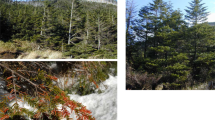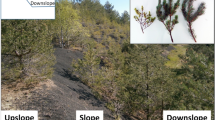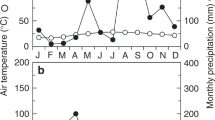Abstract
Introduction
Scots pine populations in the SE “Sistema Ibérico” range suffered a severe defoliation in the S face of the crown in isolated trees of thinned stands. This process was detected at the end of the winter 2001–2002.
Aim
We hypothesise that winter conditions may be as critical for Scots pine survival as summer drought, even for these southern populations. In this way, the possible connection between the microclimate conditions and the risk of xylem embolism during the winter of 2001–2002 was analysed.
Discussion
The additional decrease in water potential found in the affected trees could be caused by the combination of (1) low soil temperatures limiting water uptake by roots, (2) a higher vulnerability to drought-induced embolism due to the occurrence of repeated freeze–thaw cycles, and (3) high radiation events throughout the winter, increasing the loss of water by transpiration. Thus, the additional induction of embolism found in the affected trees (ca. 27%) could be caused by the combination of these factors.
Conclusion
Estimated conditions during winter 2001–2002 were extremely unfavourable, leading probably to an impaired water status and high embolism rates, which may have induced the severe defoliation observed in crowns of affected trees.








Similar content being viewed by others
References
Alía R, Moro-Serrano J, Notivol E (2001) Genetic variability of Scots pine (Pinus sylvestris) provenances in Spain: growth traits and survival. Silva Fenn 35:27–38
Andersson B, Fedorkov A (2004) Longitudinal differences in Scots pine frost hardiness. Silvae Genet 53:76–80
Anfodillo T, Pasqua Di Biscegile P, Urso T (2002) Minimum cuticular conductance and cuticle features of Picea abies and Pinus cembra needles along an altitudinal gradient in the Dolomites (NE Italian Alps). Tree Physiol 22:479–487
Breckle SW (2002) Walter’s Vegetation of the Earth. The Ecological Systems of the Geo-biosphere. Springer-Verlag, Berlin
Cañellas I, Martínez-García F, Montero G (2000) Silviculture and dynamics of Pinus sylvestris L. stands in Spain. Inv Agrar Sist Rec Forest FS 1:233–253
Cheddadi R, Vendramin GG, Litt T, François L, Kageyama M, Lorentz S, Laurent JM, de Beaulieu JL, Sadori L, Jost A, Lunt D (2006) Imprints of glacial refugia in the modern genetic diversity of Pinus sylvestris. Glob Ecol Biogeogr 15:271–282
Climent J, Costa-Silva F, Chambel MR, Pardos M, Almeida MH (2009) Freezing injury in primary and secondary needles of Mediterranean pine species of contrasting ecological niches. Ann For Sci 66:407
Cochard H (1992) Vulnerability of several conifers to air embolism. Tree Physiol 11:73–83
Cochard H, Coll L, Le Roux X, Améglio T (2002) Unraveling the effects of plant hydraulics on stomatal closure during water stress in walnut. Plant Physiol 128:282–290
Feild TS, Brodribb T (2001) Trunk water transport and freeze-thaw xylem embolism in conifer and angiosperms in a Tasmanian treeline heath. Oecologia 127:314–320
Grace J (1990) Cuticular water loss unlikely to explain tree-line in Scotland. Oecologia 84:64–68
Hadley JL, Smith WK (1987) Influence of kummholz mat microclimate on needle physiology and survival. Oecologia 73:82–90
Hurrel JW, Deser C (2009) North Atlantic climate variability: the role of the North Atlantic Oscillation. J Mar Syst 78:28–41
Jarvis PG, James GB, Landsberg JJ (1976) Coniferous forest. In: Monteith JL (ed) Vegetation and the Atmosphere, vol II, Case Studies. Academic Press, London, pp 171–240
Lu P, Joyce DG, Sinclair RW (2003) Geographic variation in cold hardiness among eastern white pine (Pinus strobus L.) provenances in Ontario. For Ecol Manag 178:329–340
Martin TA, Hinckley TM, Meinzer FC, Sprugel DG (1999) Boundary layer conductance, leaf temperature and transpiration of Abies amabilis branches. Tree Physiol 19:435–443
Martínez-Vilalta J, Piñol J (2002) Drought-induced mortality and hydraulic architecture in pine populations of the NE Iberian Peninsula. For Ecol Manag 161:247–256
Mayr S, Cochard H (2003) A new method for vulnerability analysis of small xylem areas reveals that compression wood of Norway spruce has lower hydraulic safety than opposite wood. Plant Cell Environ 26:1365–1371
Mayr S, Wolfschwenger M, Bauer H (2002) Winter-drought induced embolism in Norway spruce (Picea abies) at the Alpine timberline. Physiol Plant 115:74–80
Mayr S, Gruber A, Bauer H (2003a) Repeated freeze–thaw cycles induce embolism in drought stressed conifers (Norway spruce, stone pine). Planta 217:436–441
Mayr S, Schwienbacher F, Bauer H (2003b) Winter at the alpine timberline: why does embolism occur in Norway spruce but not in stone pine? Plant Physiol 131:780–792
Mayr S, Wieser G, Bauer H (2006) Xylem temperatures during winter in conifers at the alpine timberline. Agric For Meteorol 137:81–88
Mayr S, Cochard H, Améglio T, Kikuta SB (2007) Embolism formation during freezing in the wood of Picea abies. Plant Physiol 143:60–67
Mellander PE, Bishop K, Lundmark T (2004) The influence of soil temperature on transpiration: a plot scale manipulation in a young Scots pine stand. For Ecol Manag 195:15–28
Mellander PE, Stahli M, Gustafsson D, Bishop K (2006) Modelling the effect of low soil temperatures on transpiration by Scots pine. Hydrol Process 20:1929–1944
Peguero-Pina JJ, Morales F, Gil-Pelegrín E (2008) Frost damage in Pinus sylvestris L. stems assessed by chlorophyll fluorescence in cortical bark chlorenchyma. Ann For Sci 65:813
Pittermann J, Sperry JS (2003) Tracheid diameter is the key trait determining the extent of freezing-induced embolism in conifers. Tree Physiol 23:907–914
Pittermann J, Sperry JS (2006) Analysis of freeze–thaw embolism in conifers: the interaction between cavitation pressure and tracheid size. Plant Physiol 140:374–382
Poyatos R, Martínez-Vilalta J, Cermák J, Ceulemans R, Granier A, Irvine J, Köstner B, Lagergren F, Meiresonne L, Nadezhdina N, Zimmermann R, Llorens P, Mencuccini M (2007) Plasticity in hydraulic architecture of Scots pine across Eurasia. Oecologia 153:245–249
Poyatos R, Llorens P, Piñol J, Rubio C (2008) Response of Scots pine (Pinus sylvestris L.) and pubescent oak (Quercus pubescens Willd.) to soil and atmospheric water deficits under Mediterranean mountain climate. Ann For Sci 65:306
Pozo-Vázquez D, Tovar-Pescador J, Gámiz-Fortis SR, Esteban-Parra MJ, Castro-Díez Y (2004) NAO and solar radiation variability in the European North Atlantic Region. Geophys Res Lett 31:L05201
Querol JV (1995) Ecogeografía y explotación forestal en las serranías de Albarracín y Gúdar-Maestrazgo. Consejo de Protección de la Naturaleza de Aragón, Zaragoza, 280 p
Schwarz PA, Fahey TJ, Dawson TE (1997) Seasonal air and soil temperature effects on photosynthesis in red spruce (Picea rubens) saplings. Tree Physiol 17:187–194
Turner NC (1988) Measurement of plant water status by the pressure chamber technique. Irrig Sci 9:289–308
Acknowledgements
This study was supported by a specific collaboration agreement between CITA-Aragón and Departamento de Medio Ambiente-Gobierno de Aragón. Moreover, this study was partially supported by INIA project SUM2008-00004-C03 (Ministerio de Ciencia e Innovación). Financial support from Gobierno de Aragón (A54 research group) is also acknowledged.
Author information
Authors and Affiliations
Corresponding author
Additional information
Handling Editor: Erwin Dreyer
Rights and permissions
About this article
Cite this article
Peguero-Pina, J.J., Alquézar-Alquézar, J.M., Mayr, S. et al. Embolism induced by winter drought may be critical for the survival of Pinus sylvestris L. near its southern distribution limit. Annals of Forest Science 68, 565–574 (2011). https://doi.org/10.1007/s13595-011-0068-0
Received:
Accepted:
Published:
Issue Date:
DOI: https://doi.org/10.1007/s13595-011-0068-0




